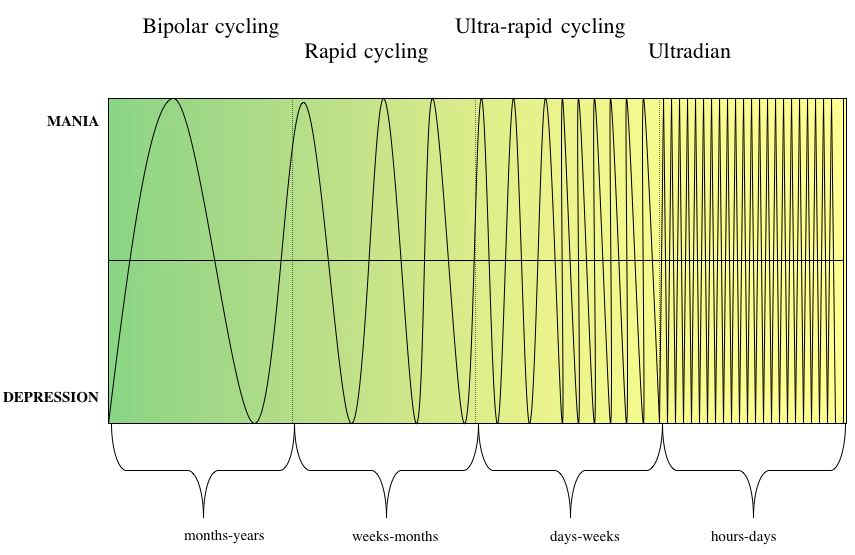Bipolar disorder is a mental health condition characterized by extreme mood swings, including episodes of mania and depression. While the disorder is widely recognized, there exists a specific subset known as rapid cycling bipolar disorder. This variant is marked by a higher frequency of mood episodes, leading to more significant challenges in management and treatment. Rapid cycling bipolar disorder affects a subset of individuals with bipolar disorder, and its diagnosis requires careful observation of symptom patterns.
In this article, we will explore the various facets of rapid cycling bipolar disorder, including its causes, symptoms, diagnosis, treatment options, and coping strategies.

What is Rapid Cycling Bipolar Disorder?
Rapid cycling bipolar disorder is a term used to describe a pattern of at least four mood episodes (mania, hypomania, or depression) within a 12-month period. These mood changes can occur rapidly, often within a matter of days or weeks. Unlike typical bipolar disorder, where manic and depressive episodes can last for extended periods, rapid cycling is characterized by a more volatile mood shift, which can significantly impact daily functioning.
Key Features of Rapid Cycling Bipolar Disorder
- Frequent Mood Episodes: Individuals with rapid cycling bipolar disorder experience multiple episodes of mood changes within a year, often leading to rapid transitions between manic, hypomanic, and depressive states.
- Severity and Duration: Each mood episode may last for a few days to a few weeks, with some individuals experiencing overlapping symptoms or rapid transitions between episodes.
- Impaired Functioning: The unpredictable nature of mood cycling can result in difficulties in maintaining relationships, employment, and other aspects of daily life.
Symptoms of Rapid Cycling Bipolar Disorder
The symptoms of rapid cycling bipolar disorder can overlap with those of standard bipolar disorder. However, individuals with rapid cycling tend to experience more frequent mood shifts and shorter durations of each phase. The symptoms are categorized based on the two main types of mood episodes: manic/hypomanic episodes and depressive episodes.
Manic and Hypomanic Episodes
Manic episodes are characterized by extreme elevated or irritable moods, whereas hypomanic episodes are less severe but share similar symptoms. In rapid cycling bipolar disorder, these episodes may appear more frequently than in typical bipolar disorder. Symptoms include:
- Increased energy or activity levels
- Racing thoughts
- Impulsiveness or risky behavior
- Decreased need for sleep
- Grandiose ideas or inflated self-esteem
- Agitation or irritability
Depressive Episodes
Depressive episodes are marked by feelings of sadness, hopelessness, and a lack of interest or pleasure in daily activities. In individuals with rapid cycling bipolar disorder, depressive episodes can follow manic or hypomanic episodes in quick succession. Symptoms of depression include:
- Persistent feelings of sadness or emptiness
- Fatigue or loss of energy
- Difficulty concentrating or making decisions
- Changes in appetite or sleep patterns
- Thoughts of death or suicide
Mixed Episodes
Some individuals with rapid cycling bipolar disorder may experience mixed episodes, where symptoms of both mania and depression occur simultaneously. This can lead to a particularly volatile mood, where the individual may experience both agitation and sadness, creating a complex symptom profile.
Causes and Risk Factors of Rapid Cycling Bipolar Disorder
The exact causes of rapid cycling bipolar disorder remain unclear, but several factors are believed to contribute to its development. Understanding these factors is crucial in managing the condition effectively.
1. Genetics and Family History
Genetics plays a significant role in the development of bipolar disorder, including rapid cycling bipolar disorder. Individuals with a family history of bipolar disorder are at a higher risk of developing the condition themselves. Specific genes related to mood regulation and neurotransmitter function may contribute to the disorder.
2. Neurobiological Factors
Imbalances in brain chemistry, particularly in neurotransmitters like serotonin, dopamine, and norepinephrine, are thought to contribute to the mood swings seen in bipolar disorder. Abnormalities in brain structure and function have also been linked to the development of the condition.
3. Environmental Triggers
Environmental factors, such as stress, trauma, or significant life changes, can trigger mood episodes in individuals with rapid cycling bipolar disorder. Substance abuse, lack of sleep, and disrupted routines can also exacerbate symptoms and increase the frequency of mood cycling.
4. Hormonal Changes
Hormonal fluctuations, especially during puberty, pregnancy, or menopause, can influence mood episodes in individuals with bipolar disorder. Women, in particular, may experience an increased risk of rapid cycling during times of hormonal changes.
Diagnosing Rapid Cycling Bipolar Disorder
The diagnosis of rapid cycling bipolar disorder is made through a comprehensive evaluation by a mental health professional. This evaluation typically involves:
- Patient History: A detailed discussion about the individual’s medical history, including previous mood episodes and family history of mental health conditions.
- Symptom Tracking: Monitoring mood changes over time through patient self-reports or mood charting. Rapid cycling is diagnosed if four or more distinct episodes of mania, hypomania, or depression occur within 12 months.
- Psychiatric Evaluation: A mental health professional will assess the individual’s symptoms, considering the criteria outlined in the Diagnostic and Statistical Manual of Mental Disorders (DSM-5).
In some cases, additional tests may be conducted to rule out other potential causes of mood swings, such as thyroid disorders or substance use.
Treatment and Management of Rapid Cycling Bipolar Disorder
The treatment of rapid cycling bipolar disorder involves a combination of pharmacological and psychological approaches to help stabilize mood and improve quality of life. Since the condition is characterized by frequent mood swings, careful management is essential to prevent episodes from escalating.
1. Medications
Several classes of medications are used to treat rapid cycling bipolar disorder. These include:
- Mood Stabilizers: Lithium is one of the most commonly used mood stabilizers to help control mood swings. Other mood stabilizers, such as valproate and lamotrigine, may also be prescribed.
- Antipsychotics: Atypical antipsychotic medications, such as quetiapine and olanzapine, may be used to treat manic or mixed episodes.
- Antidepressants: While antidepressants can help treat depressive episodes, they are typically prescribed in conjunction with a mood stabilizer to prevent triggering a manic episode.
- Anticonvulsants: Some anticonvulsant medications, such as valproic acid, are also effective mood stabilizers.
2. Psychotherapy
Cognitive Behavioral Therapy (CBT) and other forms of psychotherapy can be beneficial in helping individuals manage the emotional and behavioral symptoms of rapid cycling bipolar disorder. Therapy can also help individuals develop coping strategies for managing stress, improving self-esteem, and maintaining better relationships.
3. Lifestyle and Behavioral Changes
Maintaining a consistent sleep schedule, engaging in regular physical activity, and practicing stress reduction techniques can help reduce the frequency and intensity of mood episodes. Individuals with rapid cycling bipolar disorder should also avoid alcohol and drug use, as these can interfere with medication and exacerbate symptoms.
Prognosis and Long-Term Management
The long-term prognosis for individuals with rapid cycling bipolar disorder can vary. With appropriate treatment, many individuals can manage their symptoms effectively and lead productive lives. However, rapid cycling can be more challenging to treat, and some individuals may experience more frequent or severe episodes than others. Ongoing monitoring and adjustments to treatment plans are often necessary to maintain stability.
Coping with Rapid Cycling Bipolar Disorder
Living with rapid cycling bipolar disorder can be challenging, but there are several ways to cope:
- Educating Yourself and Your Family: Understanding the condition and educating those around you can reduce stigma and create a supportive environment.
- Building a Support Network: Connecting with others who have bipolar disorder, through support groups or therapy, can provide a sense of community and emotional support.
- Tracking Symptoms: Keeping a mood chart or journal can help identify early signs of mood shifts and help individuals manage their symptoms more effectively.
Rapid cycling bipolar disorder presents unique challenges, as individuals experience more frequent mood shifts than those with traditional bipolar disorder. However, with the right combination of medication, psychotherapy, and lifestyle adjustments, individuals with rapid cycling bipolar disorder can effectively manage their symptoms and lead fulfilling lives. Early diagnosis, personalized treatment plans, and a strong support system are critical components of successful management.

